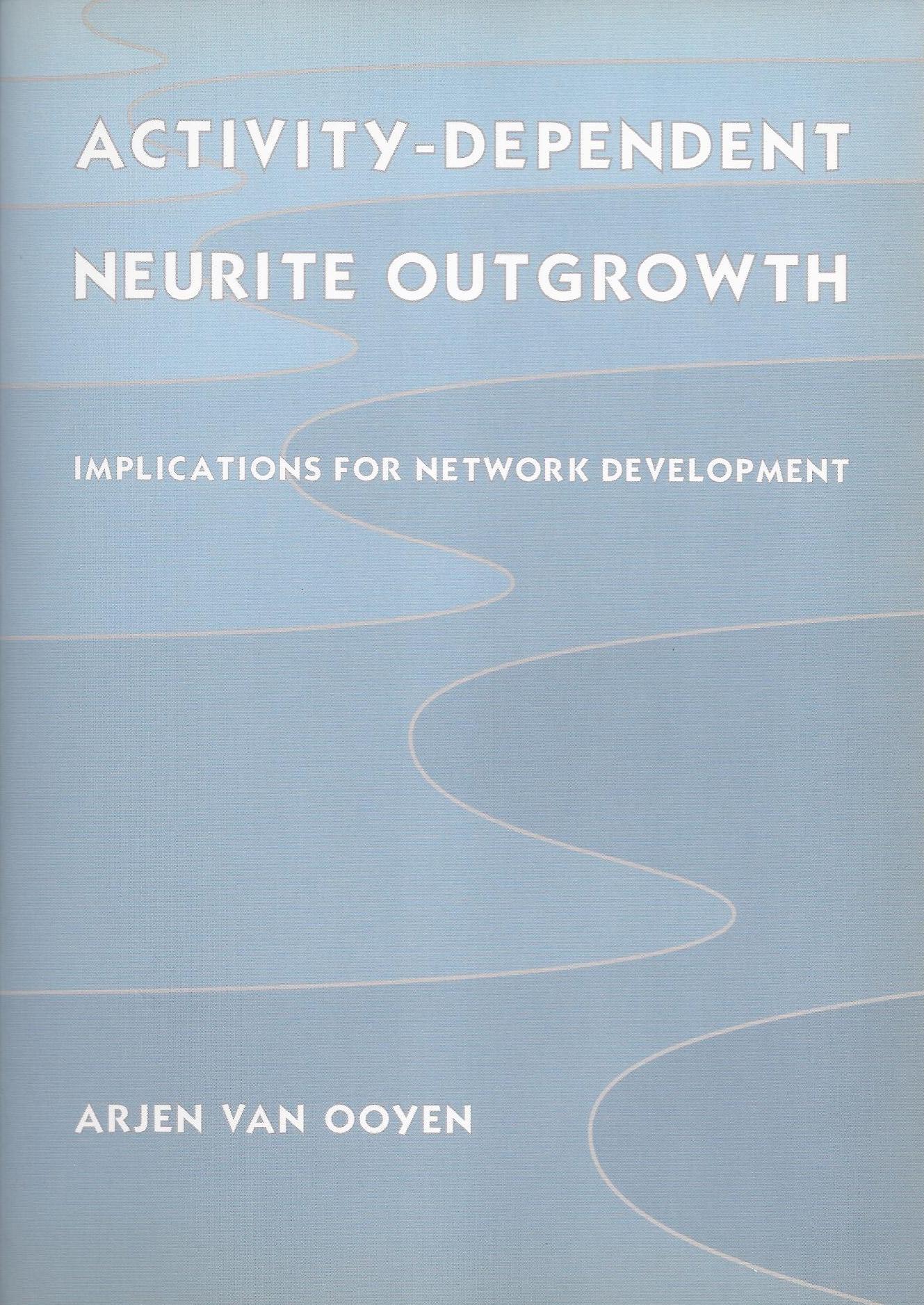My home page |
Home
Activity-Dependent Neurite Outgrowth: Implications for Network Development
Arjen van Ooyen
PhD thesis, University of Amsterdam, The Netherlands, 1995
197 pages
 Empirical studies have shown that neuronal electrical activity influences
neurite outgrowth. High activity levels cause neurites to retract, whereas low levels allow further
outgrowth. The aim of this thesis is to explore, by means of computational models, the implications of
activity-dependent neurite outgrowth for neuronal morphology and network development.
Empirical studies have shown that neuronal electrical activity influences
neurite outgrowth. High activity levels cause neurites to retract, whereas low levels allow further
outgrowth. The aim of this thesis is to explore, by means of computational models, the implications of
activity-dependent neurite outgrowth for neuronal morphology and network development.
To model the spatial extent of neurites, we provide each neuron with a circular neuritic field, the size of which depends on
the neuron's own level of electrical activity. When activity is lower than a homeostatic set-point ε,
the neuritic field expands, and when activity is higher than ε, the field retracts. Neurons connect
synaptically when their neuritic fields overlap, with a connection strength proportional to the area
of overlap. By adjusting the size of its neuritic field, each neuron effectively attempts to reach
activity level ε, at which point neuritic field size and synaptic connectivity no longer change.
In Chapter 2, we study actvity-dependent outgrowth in purely excitatory networks, and show that one
of the implications of actvity-dependent outgrowth is a transient overshoot of synaptic connectivity during development. Overshoot of
connectivity is a characteristic feature of nervous system development, in vivo as well as in vitro.
In Chapter 3, we consider a purely excitatory network in which the value of ε varies among neurons.
This variability gives rise to complex oscillations in both electrical activity and synaptic connectivity, the
time scale of which is determined by the slow time scale of neurite outgrowth. Slow fluctuations in firing rate
have indeed been observed in cerebral cortex cells, both in vivo and in vitro.
In Chapter 4, we show that even without such slow intrinsic processes, long periods of high network activity
can alternate with long periods of low activity, as a result of spontanously firing cells interfering with
activity patterns.
In Chapter 5, we examine activity-dependent outgrowth in networks that contain both excitatory and inhibitory
cells (mixed networks). Although there are no intrinsic differences between the growth properties of both cell types,
their neuritic fields nevertheless differentiate, with the neuritic fields of inhibitory cells becoming smaller
than those of excitatory cells. In the cerebral cortex, the dendritic and axonal fields of inhibitory neurons are
indeed smaller, on the whole, than those of excitatory cells.
Both purely excitatory and mixed networks are capable of self repair. After cell loss (stroke, neurodegeneration), the electrical activity of the remaining cells falls below ε, triggering neuritic field outgrowth and
formation of connections until activity is restored.
In Chapter 6, we show that in contrast to purely excitatory networks, mixed networks have multiple
equilibrium states. The network's initial conditions determine which equilibrium state is reached.
Perhaps counter-intuitively, too much inhibition during early
development prevents the normal pruning of connections and results in a network with high connectivity and
epileptic-like electrical activity. Another implication of multiple equilibrium states is the
presence of critical periods for pruning.
In Chapter 7, we study a growth function in which neurite retraction also occurs below a minimal level
of electrical activity. This leads to a wider range of behaviours during network development, with the
possibility of transient growth followed by total loss of connectivity in parts of the network.
Taken together, our results suggest that activity-dependent neurite outgrowth (a form of homeostatic
structural plasticity) has considerable potential to control neuronal morphology and network connectivity.
Full text of whole thesis (PDF)
Book contents:
Cover material
[Full text: PDF]
Contents
[Full text: PDF]
- General introduction: activity-dependent neural network development
[Full text: PDF]
[Published paper]
- Activity-dependent outgrowth of neurons and overshoot phenomena
in developing neural networks
[Full text: PDF]
[Published paper]
- Complex periodic behaviour in a neural network model with
activity-dependent neurite outgrowth
[Full text: PDF]
[Published paper]
- The emergence of long-lasting transients of activity in
simple neural networks
[Full text: PDF]
[Published paper]
- Implications of activity-dependent neurite outgrowth for
neuronal morphology and network development
[Full text: PDF]
[Published paper]
- Effects of inhibition on neural network development through
activity-dependent neurite outgrowth
[Full text: PDF]
[Published paper]
- Consequences of neurite retraction at both low and high
neuronal activity
[Full text: PDF]
[Published paper]
- Summarizing discussion
[Full text: PDF]
Glossary
[Full text: PDF]
References
[Full text: PDF]
Samenvatting
[Full text: PDF]
List of publications
[Full text: PDF]
Dankwoord
[Full text: PDF]
Curriculum Vitae
[Full text: PDF]
Full text of whole thesis (PDF)
My home page |
Home
 Empirical studies have shown that neuronal electrical activity influences
neurite outgrowth. High activity levels cause neurites to retract, whereas low levels allow further
outgrowth. The aim of this thesis is to explore, by means of computational models, the implications of
activity-dependent neurite outgrowth for neuronal morphology and network development.
Empirical studies have shown that neuronal electrical activity influences
neurite outgrowth. High activity levels cause neurites to retract, whereas low levels allow further
outgrowth. The aim of this thesis is to explore, by means of computational models, the implications of
activity-dependent neurite outgrowth for neuronal morphology and network development.